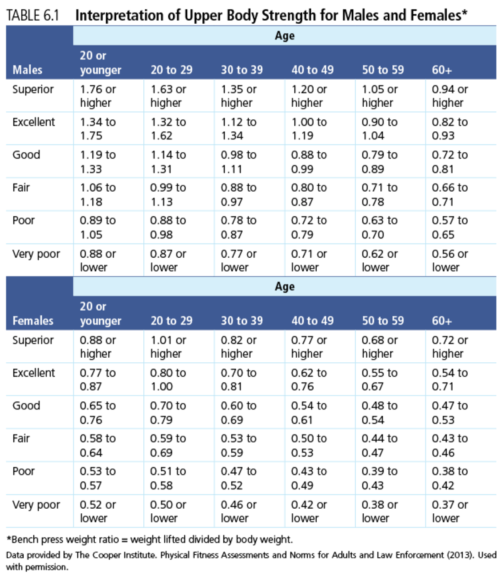Assessments for Muscular Fitness
This is an excerpt from ACSM's Complete Guide to Fitness & Health 2nd Edition by Barbara A Bushman.
There is not one test of muscular fitness that is best. Rather, different tests can be used to safely and effectively assess muscular strength or muscular endurance in various age groups. This section describes several assessments that can be used.
Assessing Muscular Strength
A common assessment of muscular strength is called the one-repetition maximum (1RM), in which the goal is to lift as much weight as possible on a strength exercise with proper technique for one repetition only. This test is time-consuming and should be performed under the supervision of a qualified fitness professional. Also, familiarization and practice sessions are critical to ensure that the test is safe and accurate.
Another option is to estimate your 1RM by lifting a submaximal weight multiple times. While different exercises can be used for this assessment, the use of multijoint exercises such as the leg press and chest press is common. With a few calculations you can estimate your 1RM and compare your performance to that of others of your age and sex.
First, multiply the number of repetitions you can perform on a given exercise by 2.5. Try to select a weight you can lift about 10 to 15 times with proper form (note that if you can lift the weight more than 20 times, the results will be more accurate if you rest and then repeat the test with a heavier weight). Subtract that number from 100 to determine the percentage of your theoretical 1RM. Then, divide that number by 100 to produce a decimal value. Finally, divide the weight you lifted by that decimal value to estimate your 1RM on that exercise.
For example, if a 35-year-old female can lift 60 pounds (27 kg) on the chest press exercise 10 times, then she can use the following steps to estimate her 1RM:
10 repetitions x 2.5 = 25
100 - 25 = 75
75 / 100 = 0.75
60 pounds / 0.75 = 80 pounds = estimated 1RM
To compare her performance with others of her same age and sex, the 1RM is divided by body weight. In the previous example, if the individual's body weight is 145 pounds (66 kg), then she can complete the calculation (80 / 145 = 0.55) and use the result (0.55) to assess her performance with table 6.1 (and to assess lower body strength with table 6.2). Note that the ratio of weight lifted to body weight is the same whether you use pounds or kilograms. For a 35-year-old female, her upper body strength is in the "fair" category. With regular resistance training she will see her strength improve as she tracks her progress. A weight she could lift only 10 times will be lifted more often before fatiguing, or she will be able to lift a heavier weight for those same 10 repetitions.

Learn more about ACSM's Complete Guide to Fitness and Health, Second Edition.
More Excerpts From ACSM's Complete Guide to Fitness & Health 2nd EditionSHOP

Get the latest insights with regular newsletters, plus periodic product information and special insider offers.
JOIN NOW


